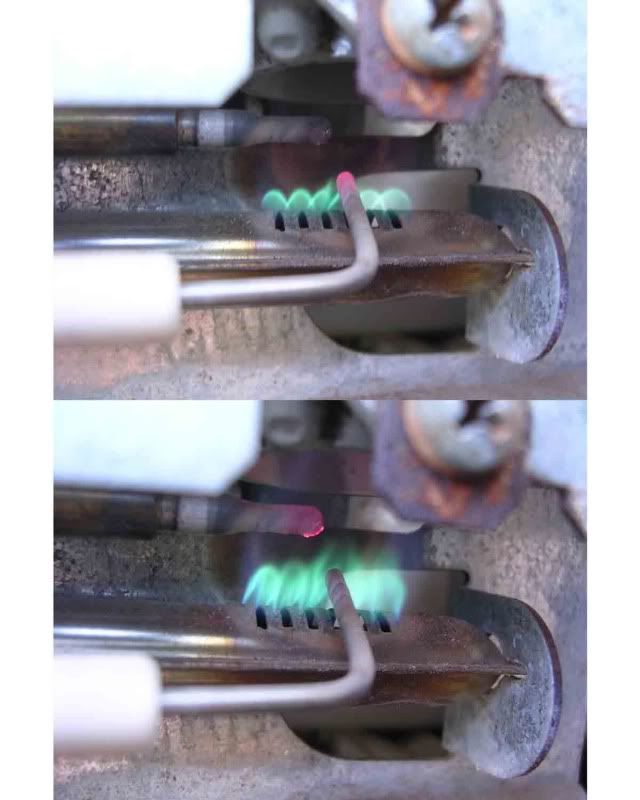The key word here is "correct". The cooling unit needs a precise, CORRECT heat to operate, not just any heat. Too high of a heat will permanently damage the cooling unit. Too low of a heat will cause the cooling unit not to function properly or not to function at all.
Troubleshooting
Usually the best way to troubleshoot the propane system is by using a manometer. A manometer is a gauge that measures gas pressure, but unfortunately most people don't have one, which means they're always working somewhat in the dark, but a lot of problems can be solved by logic and the process of elimination
All gas problems, except for leaks or a blocked chimney, show up in the burner flame. Either the burner is not putting out enough BTUs or is putting out too many BTUs for the situation. Although we've used the term BTU loosely in this section, most mortals will never be able to measure the BTUs of the flame. Just think of BTUs as "the heat output".
Inadequate or No Cooling. If the gas problem is inadequate or no cooling, and electricity is available, always test the refrigerator on electricity to eliminate the cooling unit and venting as possible problems. In other words, if the refrigerator works good on electricity, the cooling unit is good and you can concentrate on the gas problem.
Assuming the cooling unit is good and its requirements are met, the baffle is in place, and the chimney is unobstructed, poor cooling on the gas side is an incorrect flame. That simple. The most common incorrect flame is one that is too small, which is usually caused by a dirty orifice and/or burner. Remove the orifice from the burner assembly and clean it with air pressure or by soaking it in alcohol or paint thinner. DO NOT poke something like a wire through the orifice. This could easily enlarge or ruin the orifice. An enlarged orifice will put out too much heat and eventually damage the cooling unit. If there is sign of sooting or loose rust build up on the burner, blowing air pressure up the chimney and onto the burner area will clean them (protect your eyes when doing this). Don't let any loose particles blow into any open gas connections.
If, after cleaning the orifice, the problem is not solved, the orifice is still not eliminated as a possible suspect. Oil from the propane tank can accumulate around the hole of the orifice attracting dirt and making it very difficult to clean. This is a point where a manometer would come in handy. If you knew for sure that the gas pressure was correct to the orifice, you would know that the orifice is still the problem. Since you're probably working without a manometer, you'll need to make a decision. First, check out the thermostat and filter sections, then, after eliminating those two items as suspects, make a gut decision as to whether or not you want to replace the main LP gas regulator to insure proper input gas pressure or want to replace the orifice. Replace one, test the refrigerator, then replace the other if the first replacement didn't solve the problem. When working without a manometer, this is the logical way to proceed. Also, don't forget the assumptions you made at the beginning of this section and double check them.
A bad thermostat (usually one stuck in by-pass mode) will also cause no cooling.

Turn the thermostat knob on the front panel to a cooler temperature setting. Allow the refrigerator to cool for three to four hours. Turn the thermostat knob to the "Max" setting if the room temperature is warmer than normal or the refrigerator is filled with food.
Check the LP gas bottle if the flame on the burner has gone out. Refill or replace the LP gas bottle, if neede
Move items obstructing the ventilation of the refrigerator. The refrigerator requires adequate ventilation to cool effectively.
Remove food items. Open the freezer door and allow the freezer to defrost. If the evaporator is covered with heavy frost, it will not cool effectively.
Place a level on the floor of the recreational vehicle in front of the refrigerator. If it is not level, level the recreational vehicle so that the bubble is centered. The refrigerator must be level to operate properly.
Remove the screws securing the cover plate on the burner housing with a screwdriver. The cover plate is typically located on the back of the refrigerator outside of the recreational vehicle. Disconnect the lighter cable on the electrode near the burner and loosen the burner fixing screw that secures the burner. Unscrew the jet and clean it with alcohol. Blow out the jet orifice with a can of compressed air. Reassemble the jet and burner and reconnect the lighter cable. Replace the cover plate.
Unscrew the screws securing the cover plate and remove it. Inspect the burner for damage. If the burner is visibly damaged, disconnect the lighter cable and remove the burner fixing screw. Remove the old burner and install a new one. Tighten the burner fixing screw and reconnect the lighter cable. Replace the cover plate.


No comments:
Post a Comment